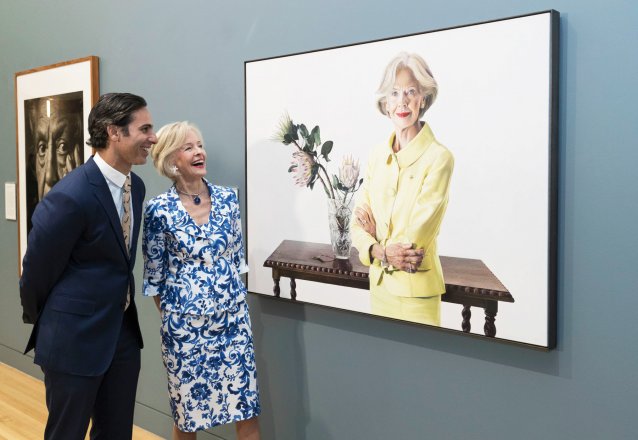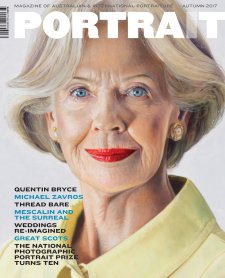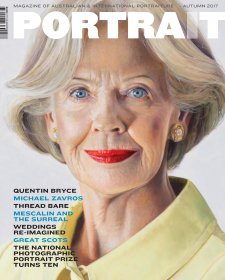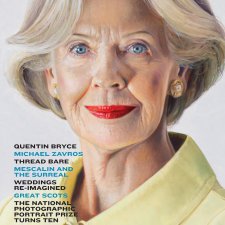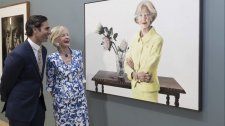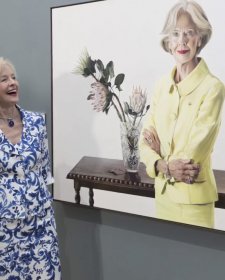During the five or so preparatory meetings between artist and sitter, Ms Bryce spoke of her garden. Zavros recalls her mentioning flowers several times. I also remember hearing Ms Bryce speak eloquently about flowers and gardens at the opening of an exhibition of William Robinson’s work, which she guest-curated, at Queensland University of Technology’s William Robinson Gallery, housed in stately Old Government House. These meetings were important to the artist; sometimes they were conversations and not formal portrait sittings. They offered Zavros an opportunity to make ‘little mental notes’ about his subject and her physical character. The meetings also gave him a chance to realise that Ms Bryce had complete faith in him, which any artist would appreciate. There was no real discussion about the direction of the portrait. This also reflects Ms Bryce’s respect for Zavros’ skills, and her bravery, even though there must have been at least some moments of doubt about the outcome.
It was during these informal meetings that Zavros noticed Ms Bryce’s jewellery. Clearly an admirer of design and quality craftsmanship, her choice of jewellery is quite bold, edgy and contemporary. Mirroring reality, the elegance, grace, poise and presence of the sitter and the striking flowers are juxtaposed with the edgy jewellery and the prickliness of the proteas, adding further layers and substance to the portrait.
As an interesting and amusing aside, Zavros, who has used blooms prolifically in his recent works, admitted to me that he did try using other flowers in the portrait. He said that unfortunately, other more decorative, pretty and delicate blooms tended to send the portrait into the realm of an advert for a funeral home. And that just wouldn't do at all!
Colour plays an integral role in the artist’s practice, and is also something we associate with Quentin Bryce.
She loves colour and can wear strong, bright shades with a dignified exuberance that reflects her full and colourful life. The stunning yellow suit in this portrait has significance for Zavros, as he remembers it from the day that Ms Bryce officially opened the Margaret Olley Art Centre. Zavros recalls how effortlessly she carried the strong colour as she spoke from a marquee before hundreds of assembled guests. Interestingly, yellow was one of Olley’s favourite shades too, a fact I have no doubt Ms Bryce would have been aware of through her friendship with the late artist, and knowledge of her work.
This portrait had much to achieve. There’s no doubt that the artist would have wished for his subject to be pleased with the finished product. And, as a commission, there’s also an element of the desire to satisfy the client, not only in depicting a likeness of the subject, but also in creating a work for the National Collection. These are daunting responsibilities in themselves. Perhaps, though, the greatest sense of obligation for the artist is to satisfy the public. A vital element in producing a successful portrait is to include viewers as participants in the end product – almost to instil a sense of pride in the work, especially when the subject is so admired by so many. It is human nature for people to form an opinion or idea concerning the type of person a public figure like Quentin Bryce might be. It is part of the remit of the portraitist to be aware of this voyeuristic curiosity and to satisfy it – to provide a view of sorts, into the subject’s world. An artist has to present some clues, and weave a narrative thread through the picture to link them with the subject. Inevitably the audience may bring some of their own attitudes and experiences to their reading of the portrait, and ultimately this will influence their interpretation and opinion of the work. I find all this quite fitting, as Zavros’ practice is more about role play than portraiture, so individual interpretation plays a key role.
This work is a perfect union of portraiture and still life. The artist has imbued the painting with his inherent respect for both genres, very much in line with the regard he has for his sitter, and the responsibility of delivering all that a portrait of such an influential Australian demands. He has also remained true to his own practice.
The portrait presents fitting recognition of Quentin Bryce’s achievements and dedication to the Australian people, through her work, and I am sure it will earn a place in the hearts of visitors as one of the Collection’s most admired pieces.

